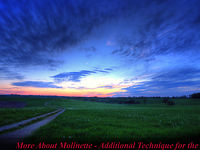En savoir plus sur Molinette - Close Embrace
One thing that's interesting in molinette in close embrace that we don't talk about is that it seems to want to be a little faster.
In open embrace, on a forward/side, typically it can go in this long controlled way. In close embrace, because it's so much smaller, usually it becomes more staccato by stopping.
So that, if you do a quick, quick, slow, then slow becomes a stop where in open embrace that slow goes through. Not only does the distance radically change the follower's styling but it also changes the musical dynamic within the same timing.
- Nom d'artiste:
- Carlos Libedinsky
- Titre de la chanson:
- El Día Despues
- Titre de l'album:
- The Rough Guide To Tango
- Site de l'artiste:
- http://www.carloslibedinsky.com/en/index.html
(From Wikipedia): Carlos Libedinsky is an Argentine musician, composer and producer. He is most renowned for his neo-tango project, Narcotango.
- 00:31
- And so that’s doing molinette in close embrace,
which is not - - 00:35
- Very different animal.
- 00:36
- Not nearly as easy as doing molinette
in open embrace. - 00:39
- You know, at this point everyone turns off
the video. - 00:42
- Yes.
- 00:44
- For the followers, a lot of the idea is about
keeping the right distance. - 00:48
- So you want to stay the same distance
and we've said that over and over. - 00:50
- But how do you stay the same distance,
when the distance is this big. - 00:54
- And the answer is, if you see the styling of my feet…
- 01:06
- ..I’m cutting behind and it’s that tight, right?
So your backstep becomes this. - 01:13
- And that way because you don’t have that much
rotation in your hips... - 01:15
- ..because your chest is fixed.
- 01:17
- So you have much less rotation in your hips.
- 01:21
- So there’s your cut.
- 01:22
- On your side step you have more pivot
and then you step side, around. - 01:27
- On your front step, instead of stepping front,
it almost becomes a pivot with a cross. - 01:32
- N. A go nowhere ocho.
D. A go nowhere ocho. And then you pivot some more and you step side. - 01:35
- It’s that tight.
- 01:45
- For the leaders, really if anything I want you to stay a little bit back weighted.
- 01:51
- So you’re on the balls of your feet.
- 01:53
- But if you lean at her, at all,
even in the least bit then... - 01:55
- ..then she sort of flies off into oblivion,
taking you with her. - 01:59
- They’re like, “That doesn’t sound so bad.”
It is. It is. There are better ways. - 02:03
- So as you’re here for example, I just turn and
she’ll cut around me. - 02:16
- That was kind of fun.
- 02:19
- And a lot of close embrace,
a lot of close embrace is about... - 02:22
- ..finding the space when
there’s no space. - 02:26
- That's really right.
- 02:27
- So for example if she’s here and I’m here
and you say, “There’s no space.” - 02:31
- But at the same time.
- 02:35
- So he’s following now.
- 02:36
- Right, I’m following. I’m the follower.
My right arm is up. - 02:39
- But I want you to imagine that right here between you...
- 02:42
- ..your body could slide past and turn for the followers,
that you create space where there’s none. - 02:47
- If we’re talking about a gancho
and she has her foot out… - 02:50
- ..right here we’re still in close embrace.
But you know it barely needs to move. - 02:56
- So I want you to think that you can use the
rotation of your upper body somewhat… - 02:59
- ..and especially the lower body a lot
to make things work. - 03:04
- And that’s very obvious in this step.
Let me follow once, so I’m the follower. - 03:08
- Oh boy.
- 03:18
- Told you that was the only way I knew
how to lead this. - 03:20
- That works. It works.


